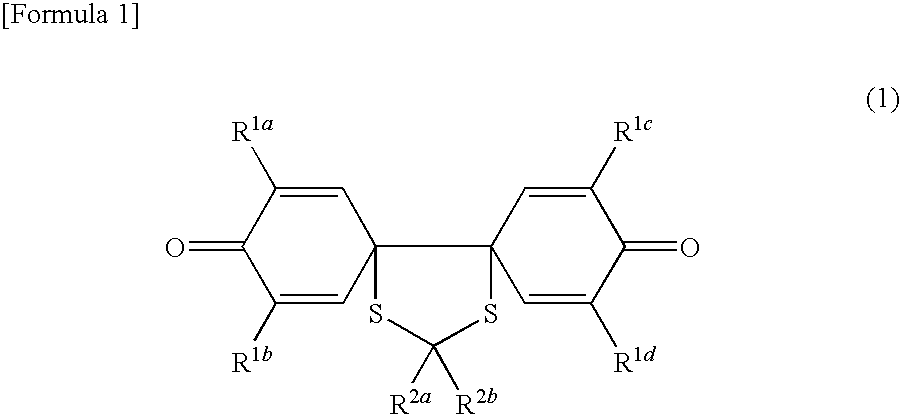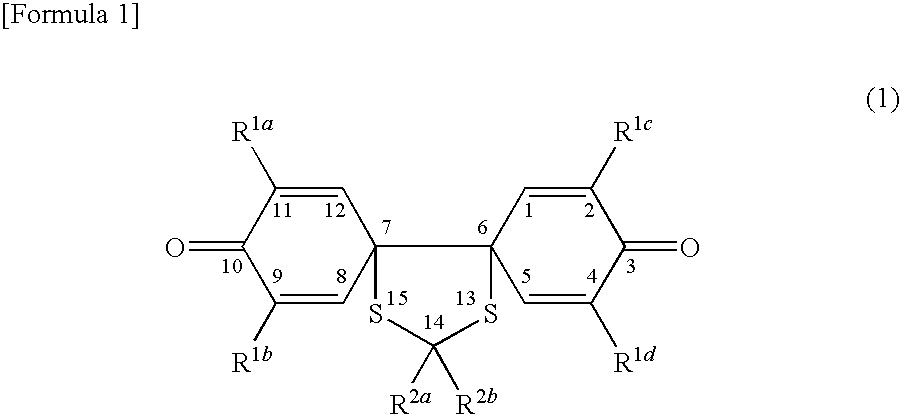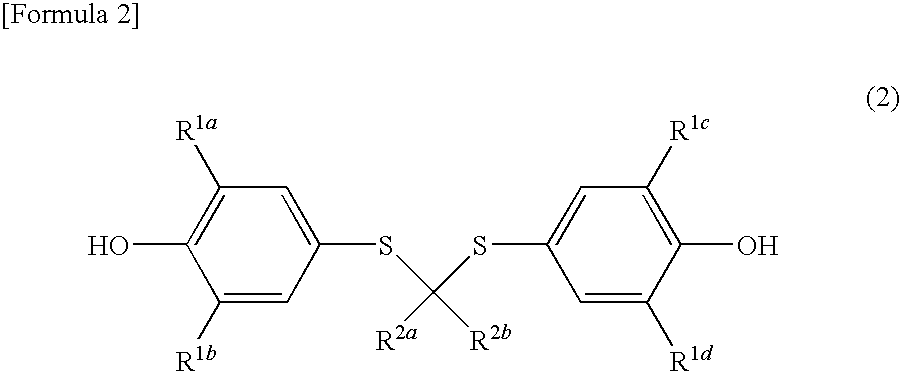Spiroquinone compound and pharmaceutical composition
a compound and spiroquinone technology, applied in the field of spiroquinone compound and pharmaceutical composition, can solve the problems of difficult to say that these probucol compounds induce fully stable and continuous abca1, and achieve excellent abca1 stabilization action, specific structure, and excellent abca1 stabilization
- Summary
- Abstract
- Description
- Claims
- Application Information
AI Technical Summary
Benefits of technology
Problems solved by technology
Method used
Image
Examples
example 1
Synthesis of 14-carboxyethyl-14-methyl-2,4,9,11-tetrakis(t-butyl)-13,15-dithiadispiro[5.0.5.3]pentadeca-1,4,8,11-tetraene-3,10-dione
(i) Synthesis of 4,4-bis(3,5-di-t-butyl-4-hydroxyphenylthio)pentanoic acid
[0124]To a solution of 2,6-di-t-butyl-4-mercaptophenol (4.77 g, 20.0 mmol) in isopropyl ether (50 mL) was added levulinic acid (1.16 g, 10.0 mmol) and a catalytic amount of concentrated hydrochloric acid. The mixture was heated under reflux over 10 days. The solvent was distilled off from the reaction mixture, and the resulting residue was purified by a flash column chromatography (filler: manufactured by Kanto Kagaku, K.K., 60Nmesh40-100, developing solvent: n-hexane / ethyl acetate (volume ratio)=5 / 1 to 2 / 1) to give 4,4-bis(3,5-di-t-butyl-4-hydroxyphenylthio)pentanoic acid (yield 935 mg and 16%).
[0125]mp: 90-92° C.
[0126]1H-NMR (CDCl3) δ: 1.31 (3H, s), 1.43 (36H, s), 1.92-1.98 (2H, m), 2.76-2.82 (2H, m), 5.37 (2H, s), 7.41 (4H, s)
(ii) Synthesis of 14-carboxyethyl-14-methyl-2,4,9,11...
example 2
Synthesis of 14-methoxycarbonylmethyl-14-methyl-2,4,9,11-tetrakis(t-butyl)-13,15-dithiadispiro[5.0.5.3]pentadeca-1,4,8,11-tetraene-3,10-dione
[0130]Methyl 3,3-bis(3,5-di-t-butyl-4-hydroxyphenylthio)butanoate was synthesized in the same manner as in Example 1 except for using 10.0 mmol of methyl acetoacetate instead of levulinic acid in the step (i) of Example 1.
[0131]1H-NMR (CDCl3) δ: 1.44 (36H, s), 1.57 (3H, s), 2.05 (2H, s), 3.70 (3H, s), 5.39 (2H, s), 7.46 (4H, s)
[0132]Further, an objective compound was synthesized in the same manner as in Example 1 except for using methyl 3,3-bis(3,5-di-t-butyl-4-hydroxyphenylthio)butanoate instead of 4,4-bis(3,5-di-t-butyl-4-hydroxyphenylthio)pentanoic acid as the raw material in the step (ii) of Example 1.
[0133]mp: 124-126° C.
[0134]1H-NMR (CDCl3) δ: 1.18 (18H, s), 1.20 (18H, s), 2.12 (3H, s), 3.26 (2H, s), 3.75 (3H, s), 6.80-6.89 (4H, dd, J=2.7 Hz, 21.1 Hz)
example 3
Synthesis of 14-methyl-2,4,9,11-tetrakis(t-butyl)-13,15-dithiadispiro[5.0.5.3]pentadeca-1,4,8,11-tetraene-3,10-dione
[0135]Bis(3,5-di-t-butyl-4-hydroxyphenylthio)ethane was synthesized in the same manner as in Example 1 except for using 10.0 mmol of acetaldehyde instead of levulinic acid in the step (i) of Example 1.
[0136]1H-NMR (CDCl3) δ: 1.43 (36H, s), 1.55 (3H, d, J=6.8 Hz), 4.24 (1H, q, J=6.8 Hz), 5.29 (2H, s), 7.37 (4H, s)
[0137]Further, an objective compound was synthesized in the same manner as in Example 1 except for using bis(3,5-di-t-butyl-4-hydroxyphenylthio)ethane instead of 4,4-bis(3,5-di-t-butyl-4-hydroxyphenylthio)pentanoic acid as the raw material in the step (ii) of Example 1.
[0138]mp: 131-133° C.
[0139]1H-NMR (CDCl3) δ: 1.19 (36H, s), 1.82 (3H, d, J=6.2 Hz), 5.09 (1H, q, J=6.2 Hz), 6.71-6.72 (2H, d, J=3.0 Hz), 6.81-6.82 (2H, d, J=3.0 Hz)
PUM
| Property | Measurement | Unit |
|---|---|---|
| Mass | aaaaa | aaaaa |
| Mass | aaaaa | aaaaa |
| Mass | aaaaa | aaaaa |
Abstract
Description
Claims
Application Information
 Login to View More
Login to View More - R&D
- Intellectual Property
- Life Sciences
- Materials
- Tech Scout
- Unparalleled Data Quality
- Higher Quality Content
- 60% Fewer Hallucinations
Browse by: Latest US Patents, China's latest patents, Technical Efficacy Thesaurus, Application Domain, Technology Topic, Popular Technical Reports.
© 2025 PatSnap. All rights reserved.Legal|Privacy policy|Modern Slavery Act Transparency Statement|Sitemap|About US| Contact US: help@patsnap.com



